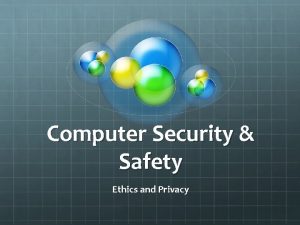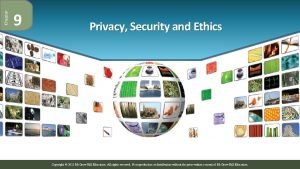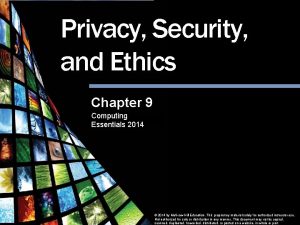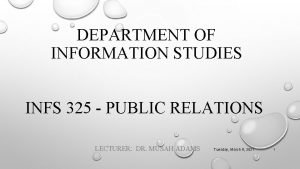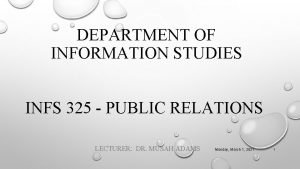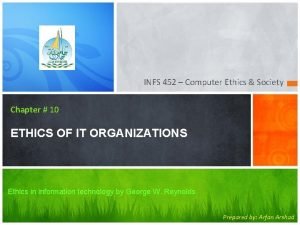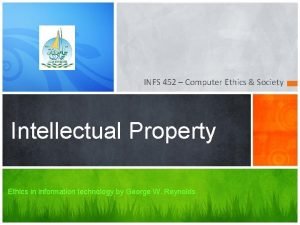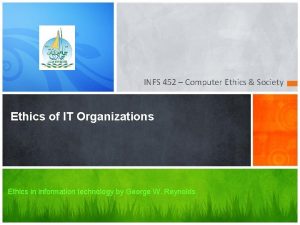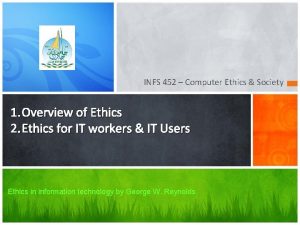INFS 452 Computer Ethics Society Chapter 4 Privacy











- Slides: 11

INFS 452 – Computer Ethics & Society Chapter # 4 Privacy Ethics in information technology by George W. Reynolds Prepared by: Arfan Arshad

Introduction • The use of information technology in business requires balancing the needs of those who use the information that is collected against the rights and desires of the people whose information is being used. • On the one hand, information about people is gathered, stored, analyzed, and reported because organizations can use it to make better decisions. • Some of these decisions, including whether or not to hire a job candidate, approve a loan, or offer a scholarship, can profoundly affect people’s lives. • In addition, the global marketplace and intensified competition have increased the importance of knowing consumers’ purchasing habits and financial condition. • Companies use this information to target marketing efforts to consumers who are most likely to buy their products and services. • Organizations also need basic information about customers to serve them better. It is hard to imagine an organization having productive relationships with its customers without having data about them. • Thus, organizations want systems that collect and store key data from every interaction they have with a customer.

Information Privacy Information privacy is the combination of • communications privacy (the ability to communicate with others without those communications being monitored by other persons or organizations) and • data privacy (the ability to limit access to one’s personal data by other individuals and organizations in order to exercise a substantial degree of control over that data and its use).

Data & Information Privacy Guidelines

KEY PRIVACY ISSUES 1. Identity Theft Identity theft occurs when someone steals key pieces of personal information to impersonate a person. This information may include such data as name, address, date of birth, Social Security number, passport number, driver’s license number, and mother’s maiden name. Four approaches are frequently used by identity thieves to capture the personal data of their victims: (1) Create a data breach to steal hundreds, thousands, or even millions of personal records; (2) Purchase personal data from criminals; (3) Use phishing to entice users to willingly give up personal data; and (4) Install spyware capable of capturing the keystrokes of victims.

Contd…… 2. Consumer Profiling • Companies openly collect personal information about Internet users when they register at Web sites, complete surveys, fill out forms, or enter contests online. • Many companies also obtain information about Web surfers through the use of cookies, text files that a Web site can download to visitors’ hard drives so that it can identify visitors on subsequent visits. • Companies also use tracking software to allow their Web sites to analyze browsing habits and deduce personal interests and preferences.

Contd…… 3. Treating Consumer Data Responsibly • When dealing with consumer data, strong measures are required to avoid customer relationship problems. • The most widely accepted approach to treating consumer data responsibly is for a company to adopt the Fair Information Practices and the privacy guidelines. • Under these guidelines, an organization collects only personal information that is necessary to deliver its product or service. • The company ensures that the information is carefully protected and accessible only by those with a need to know, and that consumers can review their own data and make corrections. • The company informs customers if it intends to use customer information for research or marketing, and it provides a means for them to opt out.

Contd…… 4. Workplace Monitoring • Many organizations have developed a policy on the use of IT in the workplace in order to protect against employee abuses that reduce worker productivity or expose the employer to harassment lawsuits.

Contd…… 5. Advanced Surveillance Technology • A number of advances in information technology—such as surveillance cameras, facial recognition software, and satellite-based systems that can pinpoint a person’s physical location—provide exciting new data-gathering capabilities. • However, these advances can also diminish individual privacy and complicate the issue of how much information should be captured about people’s private lives. • Camera Surveillance, Facial recognition systems and GPS chips are some of the latest and advanced surveillance technologies used in this respect.

Safeguarding your identity data

Question & Answer Session
 Is a destructive event a program is intended to deliver.
Is a destructive event a program is intended to deliver. Cvs privacy awareness and hipaa training answers
Cvs privacy awareness and hipaa training answers Chapter 9 privacy security and ethics
Chapter 9 privacy security and ethics Chapter 9 privacy security and ethics
Chapter 9 privacy security and ethics Chapter 9 privacy security and ethics
Chapter 9 privacy security and ethics Infs 325
Infs 325 Semdr communication model
Semdr communication model Infs 325
Infs 325 Infs 2022
Infs 2022 Infs sponsorship code
Infs sponsorship code Find the number of moles of argon in 452 g of argon.
Find the number of moles of argon in 452 g of argon. Cse 452
Cse 452
